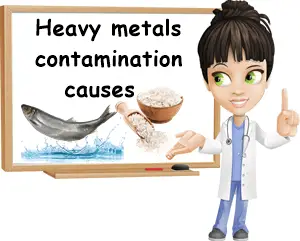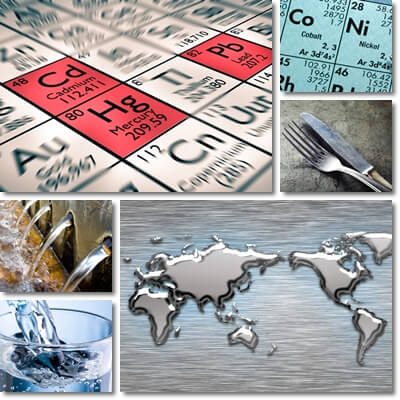The issue of heavy metals contamination and its effects on human health and the environment is one of the biggest health concerns in recent years. This is because heavy metals are a major source of ill health, producing side effects both in the short and long term and sometimes irreversible damage to the nervous system, kidneys and other systems and organs despite treatment. Learning what are the causes of heavy metal contamination and recognizing the symptoms are the first steps towards receiving appropriate medical treatment, preventing dangerous side effects as well as avoiding environmental and food sources of heavy metals in the future.
Why are heavy metals toxic? The reason why heavy metals are bad for your health is because they are toxic elements the body can’t break down and eliminate like it does food. So they form deposits in soft tissues and stay in the body. But since heavy metals are naturally toxic even in small amounts, the fact that they accumulate in the body means they will produce toxic effects for your health. The longer the exposure and the greater the accumulation of a certain heavy metal, the worse the side effects. Also, contamination can occur via ingestion, inhalation or skin contact.

What are toxic heavy metals? By definition, toxic heavy metals are metal elements or elements with metal properties that have a higher density and toxic effects even in low concentrations. They occur naturally in the earth, but can be found in water sources and air as a result of human activity and are toxic for the environment and all life forms because they accumulate in tissues and cannot be eliminated naturally from the body. The most common toxic heavy metals include arsenic, mercury, lead, cadmium, cobalt, tin and nickel. Other elements like iron, zinc, selenium, copper and chromium are both nutrients in trace amounts and toxic heavy metals when they accumulate in excess amounts in the body.
What are the causes of heavy metal contamination?
The main cause of heavy metal contamination is human industrial activity and the resulting pollution of the environment. Sources of heavy metals include:
1) Human activities such as welding, mining, metal work, cosmetic industry, pharmaceutics, certain construction work, gasoline production, coal burning etc.
2) Manufacture of pesticides, batteries, thermometers, cables, electrical wires, lamps, solar panels, ovens, cars, phones, engines, pottery, linoleum, paint, glass, dental amalgams, etc.
3) Industrial waste is a major source of heavy metals contamination.
4) Old water supply systems (aging pipes that slowly release microelements in the water supply).
5) Irrigation systems (either the pipes are old and rusty or the water used for crops is contaminated).
6) Air pollution from car exhaust fumes, factory fumes, burning plastic, cigarette smoke etc.
7) Water and soil pollution from industrial activities, improper disposal of waste etc.
8) Other sources: cookware (especially pans and pots), cosmetics, skin care products, hair dye, unregulated plant-based supplements, fillings or dental amalgams etc.

A second source of heavy metals contamination is food. Most food sources get contaminated via polluted soil, water and air. And common problematic foods may include:
1) Rice, a source of arsenic, especially dangerous for young children.
2) Fish and seafood in general, source of methyl-mercury, aluminum, micro-plastics etc.
Fish rich in mercury include: tuna, mackerel, king mackerel, shark, salmon, herring, tilefish, swordfish etc. Generally, larger fish that are higher on the food chain and live long enough to get big are the most toxic. Eating large amounts of fish and seafood in general causes heavy metal contamination.
3) Fizzy drinks from cans and vending machines, potential source of cadmium from pipes, aluminum from cans. But would have to be consumed in excessive amounts over long periods of time.
4) Canned foods, sources of lead, tin, aluminum, chromium, iron, copper etc.
Acidic foods in particular can corrode cans, causing tin or other heavy metals to infiltrate contents.
Examples: tomato sauce and juice, canned pineapple, citrus, apple sauce, cranberry sauce etc.
5) Cocoa, dark chocolate and other chocolate products, potential sources of lead and cadmium. However, they would have to be consumed in excessive amounts to cause significant health issues, unless heavily contaminated.
6) Coffee, potential source of cadmium, soy, source of nickel, peanuts, source of barium. Again, in the amounts they are meant to be consumed, they should not pose major health risks, unless heavily contaminated.
7) Seaweed, source of contaminants such as methyl-mercury. Should not come with risks if consumed in normal amounts (example: as seafood or as a dietary supplement).
8) Herbal supplements and cooking herbs and spices, especially those manufactured in China or developing countries with high levels of pollution and unregulated pesticide use. Examples: ginseng, ginkgo biloba, black walnut husk, echinacea etc.
9) Other supplements. Examples: creatinine dietary supplements, cocoa supplements, coffee or caffeine-based supplements.
Sometimes, even the fruits and vegetables we eat can be contaminated with heavy metals. This occurs when contaminants permeate the water bed, infiltrate soil or set on the plants via air pollution. This is also why it is recommended to eat what is in season and grown locally, so you can verify how you food is really grown and whether or not it meets organic standards. Moreover, it is recommended to avoid tap water and go for bottled water certified to come from an unpolluted area and tested for heavy metals and other contaminants.
Signs and symptoms
What are the signs and symptoms of heavy metal contamination?
1) Allergies, food sensitivities, rashes, irritation of the airways.
2) Lethargy, fatigue, drowsiness, malaise.
3) Mood swings, irritability, anxiety, depression, insomnia.
4) Mental confusion (brain fog), memory problems, forgetfulness, headaches.
5) Poor coordination, clumsiness, unsteady or abnormal walking, vertigo.
6) Muscle aches and muscle weakness, tremors, numbness, twitching, tingling in hand and feet and other similar symptoms.
7) White tongue, gum problems, metallic taste in the mouth, bad breath, changes in smell perception, especially loss of smell, vision problems, hearing loss, tinnitus (ear ringing).
8) Night sweats, chills, fever or excess sweating without a reason.
9) Loss of appetite, nausea, vomiting, diarrhea or constipation, irritable bowel, food intolerance.
10) Poor tolerance to certain medicines, poor intolerance to certain vitamins and minerals.
11) Dermatitis, hyperpigmentation, keratosis, skin flaking, irritation, pallor, bluish skin, jaundice.
12) Joint pain, stiffness, rigidity.
13) Cold hands and feet, low body temperature, fertility problems, anemia, goiter.
14) Elevated heart rate, hypertension, chest pain, palpitations, extrasystoles, tachycardia, heart failure.
These are some of the most common symptoms of heavy metal contamination. Depending on the duration of the overexposure, form of exposure and type of contaminant, general state of health, age and other factors, symptoms may differ from person to person. The greatest danger is to children who exhibit growth problems, speech problems, neurological damage, skin rashes, seizures, shock, chronic respiratory diseases, cancers etc.
Heavy metal contamination is life-threatening. Treatment itself poses long-term health risks for some people, but it is the only solution to the acute symptoms that build up in severity the longer the heavy metals remain in the body. Ultimately, if left untreated, the condition could easily result in liver, kidney or heart failure, severe neurological damage and death. Read more about how to prevent contamination and eliminate heavy metals from the body in the article here.
List of side effects
What are the side effects of heavy metal contamination? Heavy metal contamination can have both short and long-term side effects and produce damage to systems and organs that cannot always be completely reversed by treatment in cased of prolonged overexposure. Side effects may include:
1) Cancers of the skin, lungs, stomach and other organs.
2) Nerve damage, brain damage.
3) Kidney and liver damage, heart failure.
4) Respiratory disease: pulmonary edema, pneumonia and others.
5) Diseases of the stomach and intestinal tract.
6) Poor immunity or hyperactive immune system, allergies.
7) Long-term diseases: Alzheimer’s, chronic fatigue syndrome or chronic pain.
